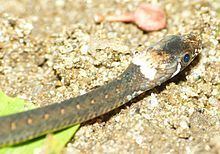Subphylum Vertebrata Suborder Serpentes Scientific name Amphiesma beddomei Rank Species | Phylum Chordata Higher classification Amphiesma | |
 | ||
Similar Snake, Amphiesma, Reptile, Amphiesma monticola, Amphiesma xenura | ||
The Nilgiri keelback or Beddome's keelback (Amphiesma beddomei ) is a species of snake found in the Western Ghats in India. The species is named after Richard Henry Beddome, 1830–1911, British army officer and botanist. It was first discovered near the Nilgiris but is now known more widely from the Western Ghats. This snake is terrestrial and feeds on toads.
Contents
Description
See snake scales for the terminology usedEye moderate, its diameter in the adult equalling its distance from the nostril; rostral just visible from above; suture between the internasals as long as that between the prefrontals; frontal larger than its distance from the end of the snout, a little shorter than the parietals; loreal as long as deep or deeper than long; one preocular; three (rarely two) postoculars; temporals 1+1 or 1+2; upper labials 8 or 9, third, fourth and fifth, or fourth, fifth, and sixth entering the eye; 5 lower labials in contact with the anterior chin shields, which are shorter than the posterior.
Scales in 19 rows, rather strongly keeled, the outer however, perfectly smooth. Ventrals 131-150; anal divided; subcaudals 65-75.
Brown above; a series of yellow spots, each between two black spots or short transverse bands, along each side of the back; upper labials yellowish with black sutures; a yellow, black-edged, oblique streak from the eye to the gape; a yellow band across the nape, behind the parietals, becoming indistinct with age; belly white, closely dotted with brown on the sides.
Total length 51–66 cm (20–26 in), tail 13–19 cm (5–7 1⁄2 in).
Habitat
Amphiesma beddomei prefers moist deciduous forests and evergreen forests.
Behavior
Although not aquatic, it can be found actively hunting from dawn to dusk on stream banks or close to other bodies of water.
Diet
It eats mainly toads.
